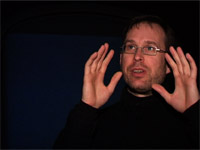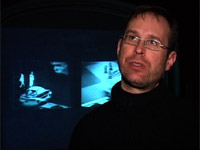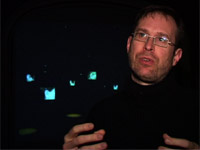|
David Rokeby's interview
at Theatre Mercelis, Brussels (Ixelles), 14 DEC 2003 |
see the video (quicktime, broadband, 16min, 15MB) or/and read the textual transcription. [version française] |
||
| At the end of the workshop that David Rokeby gave at iMAL, he made a conference at Theatre Mercelis, and was interviewed by Xavier Ess, journalist for the TV programme Cybercafe21 (RTBF). Thanks to Xavier, we publish here his complete talk with David (16 minutes). |
|
||
 |
Xavier Ess: [00:00:00] David, can you explain us what is softVNS, this software that you developed ? David Rokeby: [00:00:08] softVNS is a toolbox that I use to process video in realtime to create interactive installations and to create video installations. It's very fast and allows you to manipulate video, as if it was used as clay or paint for something, very fluid and easy to use. [00:00:31] |
||
 |
XE: [00:00:31] The main feature in the softVNS software seems to be the analysis of the movement and the fact one can play with movement in the image? DR: [00:00:41] Since about 1981, I've been working with video as a way of tracking movements, of understanding movements, of looking into the world and having the computer understand something of the world. And softVNS 2 includes in a large part tools to find people's heads, to find certain colors, to see the quality of certain movements, to play virtual switches or triggers in space, things like that. [00:01:08] |
||
 |
XE: [00:01:08] For more than 20 years, your work is about the interaction between human, human body and machine. What interests you in this? Is there a man-machine communication? DR: [00:01:26] There are 2 kinds of interaction that are going on when you have humans and machines in interaction. One is the interactions between the humans and the machines. And the second is the interactions between humans and humans through the machines. And I find both very interesting. But I say, in some ways, the one that I found most interesting is the human responding to their own refletions, their own shadows through the interactive system... Often because we don't recognize ourselves completely. We may adopt very strange relationships to our interactive shadows, we may mistake our intelligence with the system intelligence for example. And I found this relationship very interesting because I think it's important that we start to understand what the nature of our relationships with these machines is, both its positive aspects and perhaps its not so positive aspects. |
||
 |
XE: [00:02:18] Does that mean that a very simple machine can fake a human being, which is something very complex? DR: [00:02:30] Oui, oh sorry, yes,... That is because the human is always more complicated than the machine. We are much more complicated than any computer and so when you create an interactive feedback loop, the complexity of the human being fills the whole system. And some of it comes back to you as part of the response of the system. Especially because we do not know ourselves so well. We are not so aware of how our body is moving. We think we are but we are not. So the result in a system like my Very Nervous System which translates body movements into music is often surprising because we don't realise how we've moved. So we are surprised with the results, not because the results are very unusual but because our movements were different of what we thought. |
||
 |
XE: [00:03:18] In your work, there is also this aspect where technology highlights human feelings, as for instance in "Watch". In this work there are persons who do not move, the Homelesses. Can you talk about it? DR: [00:03:39] "Watch" had a very interesting birth. I had set up a situation where for the first time I could see what my computer was seeing. The computer was mostly seeing movements. I was tired of jumping around in front of my camera to generate movements for, so I pointed the camera out the window, on to the street. I lived on a very busy street at that time. And I had actually 2 processes going: one that showed the movements in the image (in this busy street, all the cars, all the people walking by, etc...). On the other side, it was showing only the stills: so the building were visible but cars, people walking by were invisible. And on the street, that happened to be many homeless people and homeless people tend to stay there on the corner and maybe hold their hands out for some money. They were the only people who were still. So on that side of the image, you see all the people who are very busy, important, and shopping and going to work are invisible, and the people who are doing nothing are visible. This was particularly interesting to me because when you live on a street with many homelesses, you create your own filters and you do not see those people any more. I was interested in the way a simple technology could turn these filters that we develop inside down upside down. |
||
 |
XE: [00:04:59] You did many works using video surveillance. These become political. Up to now, interactivity in the art was just something funny as, for instance, in these works where people enjoy playing with an interactive work to create music with their bodies. But here, these recent works are not at all funny any more? DR: [00:05:31] Yes, that's true. I think part of my experience of showing Very Nervous System - which is very exciting, fun - is that there are lot of ideas and experiences that happen in VNS that are really interesting but maybe not so much fun. The fun of VNS sometimes hides the other thinks which are very interesting. And so in a way I tried to make my work a little more boring. It sounds funny, but to make a little more boring, so that it helps you think a little bit more about the questions that are being raised. And the reason we need to ask these questions is because the technology of interactivity, of computation, of virtual reality, all these technologies are becoming more and more part of our everyday life, part of our communications with each other. I think this is in many ways a tremendous addition to our culture but in some ways it's not necesseraly such a good thing. And we need in a way to ask some questions as we adopt the technology to make sure we bring the technology into our life in the best way, and not in way that is just the easiest. So more recent pieces are perhaps more difficult because I feel it is more necessary in the face of war and terrorism with a lot of mechanical surveillance, "automatic detection" of terrorists for example, that the technology can no longer be so innocent. And so as an artist I must reflect that. |
||
 |
XE: [00:06:58] Is it the real propos of this work, 'Sorting Daemon'? Is it really inspired by September 11? DR: [00:07:04] Oui, oui... Yes. It was actually very hard to make that piece because I was making it during the build up to the war in Irak in the spring this year. And it was hard to stay focused on during an artwork. You think of an artwork that i would show in a gallery, and a small number of people would see it when a very large thing was taking place around the world. It was very distracting but I was glad finally to be able to bring the piece together in the end. Also it was interesting, I think; people are split on that piece : some people find it very terrifying because of the way it separates people from their clothes, and sort them according to head sizes and skin colors. And some people just find it very beautiful and don't find it scary at all. It was interesting to me to ask the question : was i there for effectively asking the critical question or was the technology so interesting that it distracted from the political questions? And that's the kind of question I like to keep asking myself to keep becoming a better artist because there is always things to learn, especially working in new medium where the rules aren't set. XE: [00:08:14] Maybe you should explain us how 'Sorting Daemon' works? DR: [00:08:20] 'Sorting Daemon' is set up in a gallery with a very long window looking out on the street. It's an interesting street because you have business people - it's part of the business district; there are also a lot of theaters, and also crack dealers on the corners, that's quite of mixture of different cultures. There is a camera that can pan and tilt and zoom and it's looking through the window. It's looking for people. And a person is simply something that is moving, that is tall and wide (contraty to cars which are wider than tall). When it finds a person, it looks for the flesh colors. When it finds that, it removes that, separates the face, and then it looks for the other colors. So maybe the color of your shirt and the color of your pants. And it sorts those on a separate screen where you see a whole array of faces on one side which are being sorted according to these very simple rules, and on the other side, you see bits of jeans, and bits of coats and ties and jackets, all these colors separated and sorted into the range of the rainbow. In some ways, it looks like a painting, an oil painting, very thick density layers, but this act of taking human body and pulling it apart, a very active analysis which is always taking part of things and sorting in... taking people away from their life in the street and sorting them into this arbitrary mathematical space... there is a kind of beauty but also a kind of violence there. In the end that was i was after, with that mixture of a darkness and the dark attraction of that beauty in the context of the war and the questions that are raised about privacy and freedom. XE: [00:10:10] In the title 'Sorting Daemon', does the daemon sort human beings, or can one consider each human as a potential daemon according to some power? DR: [00:10:23] The term 'daemon' in this case and the term 'Sorting Daemon' in fact is a term invented by Quik Maxwell who was a physicist, a couple of centuries ago, who was thinking about a little creature, a mythical creature. He didn't believe it existed but he proposed it for a thought experiment who would choose molecules that were cold and send them this way, and molecules who were warm and send them this way. So it's sorting hot and cold molecules. To me this is like the border guard who says these people are allowed to come in this country, and these people are not. And when you consider that now automatic cameras are being installed at the US border to detect automatically people who should be questionned and separated for potential terrorists, to me this is a sinister sorting daemon. XE: That' s true what you say? DR: [00:11:14] That's true. Whether it works very well that's another question but it certainly something that they are trying to do. If you look on the web site for the american defense department, you can find the projects that they are working on called the 'Human Id", which is human identification at a distance. The whole idea is to be able to identify by camera at great distance who a person is so that you can either protect yourself from them or capture them without any warning. |
||
 |
XE: [00:11:44]
Could you tell us something about your work "n-chant", a work made of a group of intelligent machines? While watching your video documentary, I don't know if I was afraid or fascinated while they were all singing toghether... Can you explain us the concept, and how it works? DR: [00:12:10] In n-chant, there are 7 computers, each of which is capable of wandering through its memory, so going from ideas to ideas, perhaps to the idea of car, to the idea of driving, to the idea of the road, to the idea of travel, to the idea of home sickness, etc, etc,... And with the stream of ideas, the stream of "consciousness" - i am using quotation marks because i don't mean it quite litteraly - it expresses this in proper English sentences and litlle english fragments. So it's like it is day dreaming, imagninig, and saying what it is thinking about as it wanders through its memory. But each of the computer is connected to the others and they tell each other what is interesting to themselves, and so this encourages each other to start thinking about the same things. And after maybe a few minutes you hear that what this computer is saying, what this other is saying, the one in the back becomes similar. One is talking about food, another one about being hungry, a chicken, a roasted chicken, and they slowly get together until suddenly they say the same words, approximatively the same way, and it sounds very much you are in a church and people are praying or something. However each computer is also using voice recognition. And if you walk up and talk to another computer, it tries to understand what you are saying and then it stimulates itself, it takes this new information and this creates a new set of interests for the computer, and it starts talking about this new interests. And that computer becomes a dissident, you might say, in the community. And this new information spread from computer to computer and the chant - speaking together - fall apart into a chaos of different voices. And then slowly if you leave it alone those will come back together. XE: [00:14:05] So the community is always winning? The unique, the individual can not exist? DR: [00:14:15] I don't think that the message is quite so dark. It's interesting that there is a tension between the individual and the community. There are times when it never quite gets to the chant. There are times when it is shifting set of alliances, these two who are talking together, these three and this one goes to this group,... and suddenly there is one talking on his own for some reasons. It' not quite so rigid. And it's not intended to be a depressive comment on the nature of human society so much as a way of looking at the way that we move back and forth between community feelings and individual feelings. And it's not a group of humans, it is a group of computers. And it's quite important to remember that; there are computers pretending to be human. In fact you can see the computers because they are hanging in the space. So I am more interested in computers trying to be human than in actually what humans do, because by thinking about, and creating and presenting computers trying to be human, I actually learn about a lot about how we are not computers by how my system is different from how we are as human beings. It's a strange way to think but I think you can use the computer ironically as a way to learn more about yourself as a human being because you can test your ideas about what you might be and see other fail. I think our ideas about who we are, how we operate are quite simplistic and the computer in a strange way can help us to underestand that we don' t really understand ourselves. |
||
 |
XE: [00:15:55] As a conclusion, are you an optimistic interactive artist? DR: [00:16:00] Hey...(smile). I certainly at many times in my life have been an optimist interactive artist. I am in general an optimistic person. For time to time, I will be the - what we call in English - the wet blanket, I will be the pessimistic interactive artist because there are lot of optimistic interactive artists and sometimes just out of contraryness i feel like it's time to be the other voice. I think there are many voices in general culture that are quite pessimistic about technology but not many within technology . I think that pessimistic voices are also a useful position. Not to say that technology is bad, but to say we need to look at technology carefuly because we are opening our arms to it at a very high speed; sometimes in that process we make the bad decision |
||